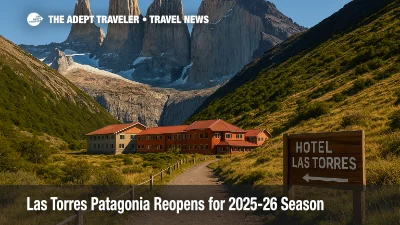Chile
Embark on an unforgettable journey and travel to Chile, a slender ribbon of land stretching along South America's western coastline, where breathtaking landscapes and vibrant culture await. Chile is a mosaic of climatic extremes, enticing travelers with sights that range from the arid beauty of the Atacama Desert to the lush vineyards of the Central Valley, where the air is laced with the sweet perfume of ripening grapes. The majestic Andes serve as a dramatic backdrop, their snow-capped peaks gazing down upon bustling cities and tranquil villages alike. As you travel through Chile, immerse yourself in the rhythmic sounds of traditional Latin music that echo through the lively streets of Santiago, and savor the rich taste of local delicacies, from hearty stews to the unparalleled freshness of Patagonian seafood. From exploring the enigmatic Easter Island to hiking through the untouched wilderness of Torres del Paine, every corner of Chile promises adventure, making it an irresistible destination that calls to the wanderlust in every traveler.
Chile Travel Season
Chile, with its vast and varied terrain stretching from the Atacama Desert in the north to the icy landscapes of Patagonia in the south, offers diverse travel experiences year-round. When planning travel to Chile, choosing the best season can significantly enhance your adventure. The peak season, which typically runs from December to February during Chile's summer, is favored by many international visitors, mainly because these months provide the warmest and most stable weather conditions across the country. This period is ideal for those looking to explore the natural beauty of Chile's diverse landscapes, from trekking in the Torres del Paine National Park to enjoying the sun-soaked vineyards of the Central Valley.
The peak travel season in Chile corresponds with holiday periods in the Northern Hemisphere, leading to larger crowds, especially in popular tourist hotspots like Santiago, Valparaíso, and the Lake District. Prices for accommodations and flights are generally at their highest, so booking well in advance is recommended if you plan to travel to Chile during the summer months. This high season is perfect for engaging in outdoor activities such as hiking, surfing, and exploring the many national parks, but be prepared for busy trails and lively tourist areas.
For those seeking a more tranquil travel experience in Chile, consider visiting during the shoulder seasons, which run from September to November (spring) and March to May (autumn). These months provide favorable weather conditions—mild temperatures and lesser chances of rain—ideal for exploring both the northern deserts and southern fjords with fewer crowds. Moreover, visiting during these periods means you can often enjoy lower prices on accommodations and flights. Springtime travel to Chile offers the added benefit of witnessing the blossoming of the stunning spring flora, while autumn paints the Andes and vineyards in vibrant hues of orange and red.
Travelers visiting Chile in the off-peak season, which occurs during the winter months of June to August, can take advantage of smaller crowds and the unique opportunity to enjoy Chile's winter sports. The Andean mountains boast some of the best skiing and snowboarding resorts, including Valle Nevado and Portillo, attracting enthusiasts of winter activities from around the world. Additionally, cultural events such as the Fiesta de San Pedro and the Festival Internacional de Cine de Santiago offer rich cultural experiences that enrich any travel itinerary.
As you plan your travel to Chile, it's essential to consider local festivities and national holidays that may impact your experience. For instance, the popular Fiesta Patrias in September brings celebrations across the nation with parades, music, and traditional foods. Whether it's the vibrant summer festivals or the more subdued winter months, understanding the rhythm of local life enhances the travel experience, offering insights into the rich culture and history of Chile.
The Weather and Seasons in Chile
Traveling to Chile offers visitors the opportunity to experience diverse and varied weather conditions, thanks to its extensive length running from the Atacama Desert in the north to the mountainous and glacial regions in the south. The climate in Chile ranges from arid in the north, Mediterranean in the central regions, and temperate and humid in the south, providing unique travel experiences year-round.
Weather in Northern Chile
The northern part of Chile, including the Atacama Desert, is known for its arid climate. It is one of the driest places on earth, with some areas receiving almost no rainfall. Travelers can expect sunny weather with temperatures ranging from 77°F to 95°F (25°C to 35°C) during summer months, and cooler temperatures from 59°F to 77°F (15°C to 25°C) in winter. This area is ideal for adventure seekers traveling to Chile for activities such as stargazing, sandboarding, and exploring surreal landscapes.
Weather in Central Chile
Central Chile, including cities like Santiago, Valparaíso, and the wine country, experiences a Mediterranean climate. Summers (December to February) are warm and dry, with temperatures averaging between 85°F and 95°F (29°C to 35°C), while winters (June to August) are cooler and wetter, with temperatures ranging from 45°F to 65°F (7°C to 18°C). This makes it a popular travel destination throughout the year, but wine enthusiasts may find spring (September to November) particularly favorable for vineyard tours and wine tastings, as the weather is mild and the landscapes vibrant.
Weather in Southern Chile
Southern Chile, home to Chilean Patagonia, exhibits a more temperate and humid climate. The summer months are relatively mild, with temperatures typically ranging from 50°F to 61°F (10°C to 16°C), while winter sees colder temperatures between 32°F and 46°F (0°C to 8°C). Rain is more frequent in the south, particularly during the winter months. Travelers seeking to explore the stunning natural beauty of Torres del Paine or the fjords should consider traveling to Chile during the shoulder seasons of spring and autumn when the weather is more stable, and crowds are fewer.
Best Time for Travel to Chile
The best time to travel to Chile largely depends on the region and the activities planned. Generally, summer is ideal for visiting southern regions and enjoying outdoor adventures. Meanwhile, central Chile offers pleasant conditions throughout late spring and early autumn, catering to both city exploration and nature outings. National holidays and local festivals, such as Fiestas Patrias in September, may coincide with favorable weather and provide cultural highlights for travelers. Regardless of when you choose to travel to Chile, the country's varied climates offer unparalleled experiences for every season.
Accepted Payment Methods and Other Payment Information in Chile
When you travel to Chile, understanding the local payment options can significantly enhance your experience. Chile's official currency is the Chilean Peso (CLP), and it is recommended to familiarize yourself with the denominations and exchange rates before your journey. You can easily obtain local currency from ATMs widely available across cities, airports, and towns. Major banks provide reliable ATM services, allowing travelers to withdraw money as needed.
Using credit cards in Chile is generally convenient, with Visa and Mastercard being the most widely accepted. These cards can be used in a variety of establishments, including hotels, restaurants, and shops. Many businesses also accept American Express, although it might not be as universally accepted as Visa and Mastercard. Discover card users may find usage more restrictive, as many smaller merchants do not accept this card type. It is advisable to carry a couple of different card options if planning to rely solely on credit cards during your stay.
Cash usage is common in Chile, especially in more rural areas or small businesses that might not accept credit cards. For travelers venturing outside the major urban centers, having cash on hand is crucial. Cash is often required for public transportation, markets, and some local restaurants, so consider carrying small denominations for easier transactions.
Tipping in Chile is customary in specific contexts. In restaurants, a tip, known as "propina," is typically around 10% of the total bill and is sometimes included automatically. If the tip isn’t included, it’s considered polite to add it for good service. Tipping taxi drivers isn’t obligatory, but rounding up the fare is appreciated. In hotels, porters and housekeeping staff generally receive tips for their services.
While payment options in Chile are similar to many other countries, knowing the local customs and being prepared with several options ensures a smoother travel experience. Before you travel to Chile, informing your bank about your trip may prevent your credit cards from being flagged for suspicious activity. Additionally, having a basic understanding of local customs and tipping etiquette can ensure that your travel to Chile is as enjoyable as possible.
Why You Should Travel to Chile
When considering global exploration, travel to Chile stands out as an unrivaled opportunity for those seeking diverse experiences. From stunning natural landscapes to vibrant culture, this elongated South American nation offers plenty to enthrall any traveler.
Spectacular Natural Landscapes
Travel to Chile for its breathtaking natural beauty, featuring some of the most diverse landscapes on Earth. From the arid Atacama Desert in the north—celebrated as the driest place on the planet—to the lush, glacial beauty of Patagonia in the south, Chile’s geography is nothing short of mesmerizing.
A Taste of Chilean Wine Country
Chile is home to some of the finest vineyards in the world. Enveloped by the Andes mountains and cooled by the Pacific Ocean, the country's wine regions, such as Maipo Valley and Colchagua Valley, offer tours and tastings for those eager to experience Chile’s acclaimed winemaking tradition.
Rich Cultural Heritage
Chile's cultural mosaic is as vivid as its landscapes. From the rich heritage of its indigenous peoples like the Mapuche to the vibrant influence of Spanish colonial history visible in its architecture and traditions, Chile offers a unique view into Latin American culture.
Adventure Awaits at Every Turn
For adventure enthusiasts, travel to Chile offers unparalleled opportunities. Ski down the Andes, trek through the Torres del Paine National Park in Patagonia, or explore the caves and cliffs of Easter Island. The country's varied topography ensures a range of thrilling activities for adrenaline seekers.
Urban Sophistication in Santiago
The bustling capital of Santiago provides a sophisticated urban experience. The city boasts an impressive array of museums, galleries, and eateries that offer local delicacies, perfectly balancing Chile’s past and present in its vibrant neighborhoods.
Stargazing in the Atacama
Chile is also home to some of the clearest night skies in the world, making it a paradise for astronomers and stargazers. The Atacama Desert, in particular, is renowned for its astronomical observatories, where one can peer into the vast cosmos and witness celestial wonders.
Intriguing History of Easter Island
A trip to Chile would be incomplete without visiting Easter Island, known for its mysterious moai statues. While the island’s remote location is a journey in itself, the historical intrigue and archaeological significance provide a compelling reason to travel to this Chilean outpost.
Warm and Welcoming People
While Chile's landscapes are diverse, the warmth and hospitality of its people are a constant. Whether engaging with artisans in small villages or families in bustling city markets, visitors are often struck by the friendliness and generosity of the Chilean people.
Delicious Culinary Experiences
Chilean cuisine is a delightful blend of indigenous ingredients and influences from European immigrants. Savor the taste of traditional dishes such as pastel de choclo or empanadas, and explore the variety of seafood from Chile’s extensive coastline.
Relax in Thermal Springs
For a relaxing retreat, Chile offers numerous natural hot springs found in the Andes foothills. Whether at Termas de Puyuhuapi in the picturesque fjords or Termas Geométricas in Villarrica, a soak in these thermal waters is the perfect way to unwind.
Travelers will find that Chile’s attractions are as wide-ranging as they are unforgettable, making the country a must-visit destination for those eager to explore the diverse offerings of South America.
The History of Chile
Chile, a fascinating country located on the western edge of South America, is a destination that beckons history lovers to travel with its rich historical tapestry. Home to the indigenous Mapuche people for centuries, Chile's modern history began to take shape with the arrival of Spanish conquistadors in the 16th century. The region was initially settled by Pedro de Valdivia, who founded the city of Santiago in 1541, establishing a Spanish colony that lasted until the early 19th century. The quest for independence ignited fervor across South America, and Chile wasn’t left untouched. In 1818, under the leadership of Bernardo O'Higgins and José de San Martín, Chile secured its independence, paving the way for the formation of a republic. These historical milestones provide a compelling reason for travelers to delve into Chile’s past.
A journey to Chile offers the opportunity to explore significant landmarks that narrate the country's storied past. The historic quarter of the city of Santiago is a labyrinth of colonial architecture and significant sites such as La Moneda Palace, which stands as a testament to Chile's political evolution. Further South, travelers can uncover the Chiloe Archipelago's UNESCO World Heritage-listed churches, offering a unique blend of indigenous and Spanish colonial influences. These landmarks aren’t just static relics of history; they are living artifacts, deeply integrated into the cultural identity of the nation. Embarking on a journey to Chile provides a tangible connection to pivotal moments that have shaped not just Chile but the entirety of South America.
Strategically nestled between the Andes mountain range and the Pacific Ocean, Chile's diverse geography has played an essential role in its culture and history. The Atacama Desert, one of the driest places on earth, was home to pre-Columbian civilizations, and today, archaeological sites such as the Pukará de Quitor fortresses offer a window into these ancient cultures. Likewise, Easter Island, or Rapa Nui, captivates travelers with its mysterious Moai statues, raising intriguing questions about the past inhabitants and their sophisticated artistry. Travel to Chile is, therefore, a journey through both time and place, connecting explorers with both ancient wonders and the natural beauty that has continuously influenced and inspired the human spirit in Chile.
The modern era has also significantly impacted Chile's identity, sculpting a vibrant cultural landscape that beckons exploration. The transformative events of the 20th century, such as the rule and subsequent overthrow of Pinochet’s dictatorship, are crucial chapters in the country’s history, offering insight into its resilient spirit. Today, Santiago pulsates with an energy that speaks to both tradition and innovation, inviting travelers to engage with a contemporary culture that reflects Chile's unique past. Enthusiasts delving into Chile’s recent history will find engaging narratives at the Museum of Memory and Human Rights, offering an in-depth look at the struggles and triumphs that have shaped modern Chile. This complex and compelling history ensures that any travel to Chile is filled with enriching experiences that deepen visitors’ understanding and appreciation for this unique part of the world.
The Culture of Chile
Travel to Chile promises an immersive experience into a land rich with vibrant culture and traditions. The diverse cultural influences in Chile are a tapestry woven from the threads of indigenous tribes and European settlers, primarily the Spanish. This confluence results in a unique cultural mosaic that exhibits a mix of ancient practices and modern global trends. The Mapuche people, who are the largest indigenous group in Chile, maintain a profound presence in the country’s culture. Their customs, folklore, and spiritual beliefs continue to be integral parts of Chilean identity. Visitors can delve into Mapuche traditions through various cultural preservation efforts, where rituals such as the "Nguillatun," a significant ceremony for prayers and thanksgiving, come to life.
Chile is renowned for its vibrant festivals and celebrations that invite travelers to partake in its joyous cultural expressions. The "Fiestas Patrias" in September marks the celebration of Chile's independence with parades, traditional foods, music, and dance performances known as "cueca." La Tirana, a large religious festival held in July, is yet another spectacular event, attracting thousands of pilgrims and featuring colorful dances like the "Diablada," where performers don elaborate costumes and masks. These events are a testament to how deeply ingrained music and dance are in the cultural fabric of Chile, offering a rhythmic pulse that beats at the heart of Chilean society.
Daily life in Chile is often characterized by a slow-paced, community-centric lifestyle that provides numerous cultural nuances for travelers to appreciate. The customary late lunch or "almuerzo" is a cherished tradition, often shared with family and friends. Chileans are known for their love of conversation and gatherings, with "asados," or barbecues, being a popular social event. The people have a reputation for their warmth and hospitality, welcoming tourists with open arms, making every traveler’s journey in Chile an opportunity to engage with its amiable people. This hospitality enriches the travel experience, enabling visitors to feel like part of the community as they explore the rich landscapes and urban vibrancy of the nation.
Art and music occupy a significant space within Chile's cultural landscape, offering travelers yet another reason to visit. From the poignant verses of Nobel laureate poets like Pablo Neruda to the vibrant murals that adorn the streets of Valparaíso, Chile abounds with artistic expression. The folk music genre of "Nueva Canción" features soulful melodies with guitars and socially poignant lyrics, offering visitors an auditory glimpse into the socio-political narratives that have shaped Chilean identity. Meanwhile, contemporary artists and musicians continue to innovate and contribute to the global cultural dialogue. In cities like Santiago, galleries and performance spaces buzz with creativity, showcasing modern Chilean art and music, and inviting travelers to experience first-hand the dynamic cultural vibrations of this unique South American country.
The Culinary Experience of Chile
When you travel to Chile, you're embarking on a culinary adventure that's as diverse as the country's landscapes. From the icy fjords of Patagonia to the arid Atacama Desert, Chile offers a rich tapestry of flavors reflecting its geographical diversity. The local cuisine is heavily influenced by Chile's long coastline, fruitful valleys, and the indigenous Mapuche culture, which means seafood, wines, and traditional dishes play a central role in the culinary experience. One must-try dish is the "curanto," a Patagonian feast traditionally crafted by cooking an assortment of seafood, meats, and potatoes in a hole dug in the ground, layered with hot stones. This cooking method not only retains the natural flavors and nutrients but also presents a unique communal dining experience emblematic of Chilean hospitality.
The wine scene in Chile is another remarkable aspect of its culinary offerings. As one of the largest wine producers in the world, a visit to the Central Valley vineyards is a must when you travel to Chile. Travelers can savor world-renowned varieties such as Cabernet Sauvignon and Carmenere, the latter being a rare grape that has found a notable home in the Chilean terroir after disappearing from Europe. For a more spirited tasting adventure, try "pisco," a local grape brandy that's served as a refreshing cocktail, Pisco Sour, embodying the zest and vibrancy of Chilean culture. Chilean craft beer is also gaining international acclaim, with a burgeoning industry offering styles from hop-infused IPAs to rich, malty porters.
Chile's urban centers, like Santiago and Valparaiso, are home to a burgeoning food scene where street food intertwines with fine dining. Visitors can explore bustling food markets like Mercado Central in Santiago, teeming with fresh seafood, fruits, and vegetables. It's the perfect spot to sample "empanadas," fried or baked pastries filled with meat, cheese, or veggies. Meanwhile, for a more sophisticated setting, restaurants helmed by innovative chefs offer modern takes on traditional Chilean flavors, integrating local ingredients like quinoa, avocados, and indigenous spices. The juxtaposition of vibrant street snacks with elegant dining experiences offers travelers a complete view of Chilean culinary artistry.
Culinary traditions in Chile are intrinsically linked to its culture and history, with seasonal dishes often celebrating Chile's diverse agricultural bounty. During Chile's harvest festivals, such as the Grape Harvest Festival, visitors are invited to partake in food tastings, grape stomping, and cultural events that showcase the deep-rooted connection Chileans have with their land. For those adhering to specific dietary preferences, like veganism or vegetarianism, the Chilean food scene adapts remarkably well. More restaurants and local eateries proudly offer plant-based options, often spotlighting native crops like corn and potatoes, aligning with the global shift towards sustainable eating. As such, the culinary journey through Chile becomes not just a feast for the palate but also a profound reflection of the nation's vibrant and evolving identity.
What to See and Do in Chile
When you travel to Chile, exploring the majesty of Torres del Paine National Park is a must. This gem, located in the heart of Patagonia, offers breathtaking landscapes characterized by towering granite peaks, icy blue glaciers, and stunning turquoise lakes. Adventure seekers will relish the multitude of trekking trails, with the famous "W" trek providing a glimpse into the rugged wilderness of Chile. Capture the sunrise at the base of the Torres—an unforgettable spectacle that paints the sky in shades of pink and orange.
Discover the Charms of Valparaíso's Hills
Valparaíso is a vibrant port city that showcases Chile's bohemian spirit. With its labyrinthine streets and colorful hillside neighborhoods, this UNESCO World Heritage site is a paradise for artists and dreamers. Ride the historic funiculars, explore street art on every corner, and soak up the lively culture in the bustling markets. A visit here offers solo travelers and families alike a rich tapestry of history and enchantment, set against the backdrop of the Pacific Ocean.
Embark on a Stargazing Journey in the Atacama Desert
The Atacama Desert, known as the driest place on Earth, is not only an otherworldly landscape of salt flats and geysers but also one of the best locations in the world for stargazing. The clear, unpolluted skies make for prime viewing of celestial wonders. Travelers can join guided tours to observatories or head to Moon Valley to gaze at the sky, experiencing the mesmerizing view of the Milky Way. It's a perfect escape for those seeking peace and introspection in Chile.
Visit the Mystical Island of Chiloé
The island of Chiloé is shrouded in myth and tradition, offering a unique window into ancient Chilean culture. Known for its palafitos (colorful houses on stilts) and UNESCO-listed wooden churches, this island is a cultural treasure trove. Engage with the local folklore through quaint festivals, sample traditional seafood dishes like curanto, and explore the natural beauty of Chiloé National Park. It is an enriching experience for travelers interested in history and culture.
Marvel at Santiago's Blend of Old and New
The capital city of Chile, Santiago, is a bustling metropolis that merges historical charm with modern sophistication. Visitors can explore museums such as the Museo Chileno de Arte Precolombino, wander through the historic Plaza de Armas, and take in panoramic views from the peak of Cerro San Cristóbal. The city's vibrant neighborhoods, like Bellavista and Lastarria, offer cultural performances, music, and cuisine that reflect the diverse essence of Chile. It's a dynamic experience for urban explorers and culture enthusiasts alike.
Experience the Serenity of the Marble Caves
Nestled along the shores of General Carrera Lake, the Marble Caves are a remote natural wonder sculpted by waves for over 6,000 years. Accessible by boat, the caves' swirling patterns and azure reflections create a surreal ambiance that captivates visitors. This is an ideal adventure for nature lovers who travel to Chile seeking off-the-beaten-path destinations and photographers eager to capture the ethereal beauty of these extraordinary formations.
Unearth History on Easter Island
Easter Island, or Rapa Nui, is a mysterious and isolated island that holds one of the world's greatest archaeological sites. The monumental stone statues, known as moai, symbolize the ingenuity and enigma of the island's early inhabitants. Travelers can explore the ancient stone villages, hike to the Rano Kau volcano crater, and learn about the island’s fascinating history and cultural significance. It's an extraordinary journey for those captivated by ancient cultures and remote island landscapes.
Witness the Power of Nature at Villarrica Volcano
For adventure seekers, climbing the active Villarrica Volcano near the town of Pucón is a thrilling experience. The ascent offers spectacular views over the Lake District, and on clear days, climbers can peer into the glowing depths of the lava crater. Beyond the climb, the surrounding area is perfect for outdoor activities like hiking, kayaking, and relaxing in natural hot springs, making it a vibrant destination for those who love the great outdoors.
Delve into the Tradition of Wine Tasting in the Central Valley
Chile's Central Valley is a wine lover's paradise, renowned for its sprawling vineyards and renowned wineries. Travelers can indulge in tastings of Chile's finest wines, including the signature Carménère and Cabernet Sauvignon varietals. Guided tours offer insights into the wine-making process, the region's viticulture, and the art of pairing wines with local cuisine. This cultural experience is perfect for culinary adventurers and connoisseurs seeking to explore Chile's rich winemaking heritage.
Relax in the Enchanting Lake District
The Lake District of Chile is a pristine area characterized by extensive forests, tranquil lakes, and charming towns. With its snow-capped volcanoes and lush landscapes, the region is perfect for both restful retreats and exploratory adventures. Families will enjoy the crystal-clear waters of Lake Llanquihue, while thrill-seekers can partake in activities such as white-water rafting and mountain biking. It offers an idyllic escape for those who travel to Chile seeking both relaxation and adventure in nature.
Tips & Tricks for Traveling in Chile
Travel to Chile offers a rich tapestry of experiences, from vibrant cities to breathtaking natural landscapes. To make travel in Chile a seamless experience, understanding local customs and tips can be incredibly beneficial.
Understanding Local Etiquette
When traveling to Chile, it's important to be aware of the local customs to enjoy a more genuine and pleasant experience. Chileans are generally warm and polite, placing great value on personal interactions. Greeting with a handshake is the norm in formal settings, while a kiss on the right cheek is common in casual circumstances. Always remember to use the formal "usted" unless prompted otherwise, especially when addressing older individuals or those in professional settings. This respectful attitude will endear you to locals and enhance your travel experience.
Efficient Public Transportation
For those who plan to travel around Chile, the public transportation system is a reliable and cost-effective way to explore. Santiago boasts one of the most modern metro systems in South America, making it an excellent option for city travel. Consider purchasing a Bip! card, which can be used on both buses and the metro, saving time and reducing the hassle of carrying cash. For intercity travel, long-distance buses are affordable and comfortable, with many services offering reclining seats, meals, and even Wi-Fi.
Tasting Chile's Culinary Delights
Chile's cuisine is a delightful aspect of travel to Chile, offering a delicious journey through its rich produce and unique flavors. Make sure to try traditional dishes like empanadas, cazuela, and pastel de choclo. Seafood lovers should not miss out on Chile's fresh offerings, including the famous chupe de mariscos. Visit local markets or join a cooking class for an authentic taste and a chance to learn about the ingredients commonly used in Chilean cooking.
Maximizing Your Travel Budget
Chile can be expensive, particularly in urban areas, but smart budgeting can enhance your travel experience without breaking the bank. Consider staying in hostels or guesthouses, which offer affordable lodging and often include breakfast. Dining at local eateries rather than tourist spots can save money while providing authentic flavors. Also, many attractions, museums, and parks have free entry days, allowing for budget-conscious exploration.
Embracing Chile's Diverse Landscapes
From the dramatic Atacama Desert to the lush valleys of Chilean Patagonia, exploring Chile's natural diversity is a must. For photographers and nature enthusiasts, timing your visits to key locations during golden hours—sunrise and sunset—can yield breathtaking photographs. In Torres del Paine, for instance, the lighting against the iconic towers is particularly stunning at dawn. Always check local weather reports and plan your travel accordingly to capture the best of Chile’s beauty.
Avoiding Crowds at Popular Attractions
Travel to Chile’s top attractions can often lead to encountering crowds. To enjoy a more peaceful visit, try exploring popular sites like San Pedro de Atacama and Easter Island during the shoulder seasons of spring (September to November) and fall (March to May). These times offer milder weather and fewer tourists. Additionally, visiting attractions early in the morning or later in the afternoon can help avoid peak crowd times and enhance your experience.
Learning Basic Spanish Phrases
While many Chileans speak some English, particularly in tourist areas, knowing basic Spanish phrases can significantly enhance travel in Chile. Being able to ask for directions, order food, or make small talk can lead to more meaningful interactions and can sometimes garner better service. Consider carrying a small phrasebook or downloading a translation app to assist in communication, enhancing your ability to connect with locals.
Savvy Souvenir Shopping
Chile offers a wealth of unique souvenirs, from colorful textiles to exquisite copper crafts. For authentic purchases, skip the big city stores and explore local markets such as Santiago's Feria Artisanal Santa Lucia or Pueblito Los Dominicos. These markets provide not only a wide range of handmade goods but also a chance to interact with the artisans themselves. Remember to check the origins of any lapis lazuli jewelry to ensure it’s genuinely Chilean.
Staying Safe During Your Travels
Chile is generally considered one of the safest countries in South America, but it’s still wise to practice common travel safety measures. When you travel to Chile, keep an eye on your belongings, particularly in crowded areas like bus stations and markets. Avoid walking alone late at night, especially in unfamiliar neighborhoods. It’s also a good idea to register with your embassy, so they are aware of your presence in the country in case of emergencies.
Connecting with Locals
Engaging with locals can greatly enrich your travel experience in Chile. Attend cultural events, such as traditional festivals or local music performances, to mingle with Chileans and learn more about their way of life. Consider using social media platforms or forums like Meetup to find groups with shared interests or to join local tours led by passionate residents. This not only provides a deeper understanding of the culture but fosters lasting memories and friendships.
What To Know Before You Go to Chile
When planning your travel to Chile, it's essential to familiarize yourself with the entry requirements to ensure a smooth journey. Travelers from many countries, including the United States, Canada, and most European nations, do not need a visa for stays of up to 90 days. However, it’s always wise to check the latest updates from the Chilean consulate or embassy in your country, as requirements can change. Upon arrival, visitors must present a passport valid for at least six months, and it’s advisable to have proof of onward travel. There are currently no mandatory vaccinations for travelers to Chile, but routine vaccinations like MMR (measles, mumps, rubella) and Tdap (tetanus, diphtheria, pertussis) are recommended. Additionally, hepatitis A and typhoid vaccinations are advised if you plan to visit rural areas or partake in camping and other outdoor activities.
Local Customs and Etiquette
Understanding the local customs and etiquette is vital when you travel to Chile, as it helps in making a good impression. Chileans are known for their politeness and expect the same from visitors. Greetings usually involve a handshake, and it’s polite to address people using formal titles, such as "Señor" or "Señora," until invited to use first names. When dining, wait for the host to signal the start of a meal, and keep your hands visible above the table. It's important to note that standing close during conversations is common, reflecting a preference for a warm, personal space. Additionally, dress code tends to be more conservative, especially in business or formal settings, so plan your wardrobe accordingly to respect local customs.
Transportation Options
Travel within Chile is facilitated by a variety of transportation options that cater to different budgets and preferences. Public transportation, like buses and the metro, is affordable and efficient in major cities like Santiago, Valparaíso, and Concepción. For longer distances, Chile has an extensive and comfortable bus network connecting cities across the country. Domestic flights are convenient for covering larger distances, especially if traveling from Santiago to further regions like Patagonia or the Atacama Desert. Car rentals are available for those who prefer to explore at their own pace, but it's important to familiarize yourself with local driving laws and road conditions beforehand.
Tipping Culture
While planning your travel to Chile, it's beneficial to understand the tipping culture to ensure you reward services appropriately. In restaurants, a tip of around 10% is customary and often added to your bill as a "propina sugerida" (suggested tip), but it's voluntary and can be adjusted based on service quality. For hotel staff, small tips in pesos for bellhops and housekeeping are appreciated. Tipping taxi drivers is not customary, but it's polite to round up the fare to the nearest peso.
Common Phrases
Having a few common phrases handy can significantly improve your experience when you travel to Chile. While many Chileans speak English, especially in tourist areas, knowing some basic Spanish will be invaluable. Useful phrases include "Hola" (Hello), "Gracias" (Thank you), "Por favor" (Please), "¿Cuánto cuesta?" (How much does it cost?), and "Lo siento, no hablo español" (I'm sorry, I don't speak Spanish). This effort in communicating in the local language is often warmly received by Chileans.
Health Precautions
Before embarking on your travel to Chile, it’s important to take specific health precautions. Besides the recommended vaccinations, travelers should consider travel insurance that covers medical expenses, as healthcare costs can be high without coverage. Altitude sickness can be an issue in areas like the Andes, so allow time to acclimatize. Staying hydrated and avoiding alcohol at higher altitudes can ease symptoms. Tap water is generally considered safe in urban areas, but in rural regions, bottled water is recommended to prevent gastrointestinal issues.
Communication Tips
Effective communication can significantly enhance your travel experience in Chile. For non-Spanish speakers, translation apps can be extremely useful for overcoming language barriers. It's advisable to download offline dictionaries or translation apps before arriving, as they can be helpful in areas with limited internet connectivity. English is more commonly spoken in tourist-centric locations; however, learning a few Spanish phrases can go a long way in social interactions and demonstrate respect for the local culture.
Accessibility in Chile
Travel to Chile offers an enchanting experience, albeit with various considerations for accessibility that travelers with different needs might want to take into account. Chile, with its diverse landscapes ranging from the Andes Mountains to the Pacific coastline, actively works on increasing its accessibility for tourists with limited mobility, visual, or auditory needs. While improvements are ongoing, there are already substantial efforts evident in the infrastructure and services available for travelers in Chile.
Physical Accessibility for Travelers with Limited Mobility
Chile has made notable strides in improving physical accessibility for travelers who have limited mobility or those using wheelchairs. Major cities like Santiago have upgraded their sidewalks, ensuring they are wheelchair-friendly with ramps and adequate space. Public buildings often feature accessible entrances and elevators, making navigation easier. Hotels, particularly in urban areas, frequently offer rooms with accessible features such as roll-in showers, grab bars, and wider doorways that cater to guests with mobility limitations.
Accessible Public Transportation in Chile
Public transportation in Chile is gradually becoming more accessible. In Santiago, the metropolitan public transport system, known as Transantiago, includes buses with wheelchair access and spaces specifically designed for riders with disabilities. The Santiago Metro has also been upgrading its stations to include elevators and tactile guiding paths for visually impaired individuals. Additionally, many stations feature auditory signals to aid travelers with hearing impairments. These enhancements make travel to Chile's bustling capital more convenient for those with mobility and sensory challenges.
Visual and Auditory Accommodations
For travelers with visual impairments, Chile is increasing its installation of tactile paving and Braille signage in major public areas, including transportation hubs and tourist sites. Efforts are being made to ensure public announcements in areas like airports and train stations are accessible to those with auditory challenges, sometimes offering visual information on display boards and incorporating sign language interpreters in certain services. Although more progress is needed, these steps demonstrate Chile's commitment to inclusivity.
Accessible Tourist Attractions in Chile
Several prominent tourist attractions in Chile are accessible to travelers with disabilities. The Chilean National Zoo in Santiago, for example, is equipped with ramps and pathways suitable for wheelchair navigation. The renowned Valparaíso and its historical funiculars provide accessible options, allowing visitors to experience the captivating hillside landscape. Certain wineries in the famous Casablanca Valley offer accessible tours, enabling everyone to savor the rich flavors of Chilean wine while accommodating different needs.
Accessible Accommodations for Travel to Chile
While planning travel to Chile, it is important to book accommodations that meet specific accessibility requirements. Many hotels in major cities offer accessible amenities, and some even provide detailed accessibility information on their websites. This includes room dimensions, bathroom facilities, and emergency accessibility features, ensuring that travelers can plan a comfortable stay regardless of their physical needs. Connecting with local travel agencies can also provide tailored advice and assistance for accessible trips.
Overall, while there are ongoing developments, travelers with various accessibility needs can find Chile accommodating. From accessible public transportation in urban centers to tailored experiences in tourist attractions, there’s an effort to make the beautiful landscapes and cultural experiences of Chile available to everyone. Encouragingly, Chile continues to evolve as a destination mindful of inclusivity and accessibility in its journey to becoming more universally accessible.
Health & Safety in Chile
When planning travel to Chile, it is crucial for travelers to be aware of various safety considerations, including natural disasters, crime, water safety, and potential social unrest. Each of these elements can play a significant role in ensuring a safe and enjoyable journey through this South American gem.
Natural Disaster Risks in Chile
Chile's stunning landscapes come with the caveat of being prone to natural disasters. The country is situated along the Pacific Ring of Fire, making it susceptible to earthquakes and volcanic eruptions. Travelers should familiarize themselves with earthquake safety protocols and always know the nearest exit points in buildings. Tsunamis, though rare, are also a possibility following seismic activity. Keeping abreast of local news and registering with governmental or travel safety programs can provide timely alerts and information.
Crime Concerns: Pickpocketing and Theft
Crime, including pickpocketing and theft, poses a concern in urban areas and tourist hotspots in Chile. Travelers should be vigilant in crowded places like markets, public transportation, and popular landmarks. Using money belts, avoiding displaying expensive items, and remaining aware of surroundings can significantly reduce the likelihood of becoming a victim. Additionally, consider using credit cards instead of carrying large amounts of cash, and always secure your belongings in a hotel safe.
Water Safety in Chile
While tap water in major Chilean cities such as Santiago is generally safe to drink, it is recommended to exercise caution when traveling to rural or more remote areas. In these places, bottled water or water purification methods should be considered to avoid potential health issues. Always ensure the food is thoroughly cooked and consider avoiding raw vegetables or fruits that are washed with local water in less developed areas.
Political and Social Unrest
Like many countries, Chile occasionally experiences political and social unrest, which can manifest in protests or strikes. These events are typically peaceful but can sometimes turn disruptive. Travelers are advised to avoid large gatherings and demonstrations. Monitoring local news and accessing government travel advisories can help in staying informed about the current situation during your visit to Chile.
Health and Safety Precautions
Before traveling to Chile, healthcare considerations and vaccinations should be addressed. Chile generally has a good healthcare system, especially in larger cities where private and public facilities are available. It’s advisable for travelers to have comprehensive travel insurance that covers medical expenses. While no specific vaccinations are required for entry into Chile, routine vaccinations are recommended, and travelers should consult their doctor about any additional vaccinations based on personal health needs and planned activities in Chile.
Other Places You Might Like
Patagonia, Argentina - A visit to the stunning landscapes of Patagonia in Argentina would enthrall anyone who loves the natural beauty and diverse environments of Chile. This vast region, shared by Argentina and Chile, offers unprecedented views of the otherworldly terrains that characterize the southern tip of South America. Sweeping plains, jagged mountain ranges, and massive glacial formations offer excellent opportunities for hiking, photography, and wildlife observation, mirroring the quintessential outdoor experience that travel to Chile provides.
Torres del Paine National Park, Chile - Although this national park is indeed located in Chile, it's magnetic allure compels travelers to explore all corners of the park, showcasing a stunning range of geographical features and diverse ecosystems that truly represent the essence of Chile. Ideal for those who travel to Chile to experience nature at its rawest, Torres del Paine offers crystal-clear lakes, ancient forests, and powerful rivers that challenge and inspire adventure seekers. The iconic granite peaks and awe-inspiring scenery make it an essential destination for anyone captivated by the grandeur of the outdoors.
Uyuni Salt Flats, Bolivia - The ethereal landscape of the Uyuni Salt Flats in Bolivia, the largest of its kind in the world, would enchant anyone familiar with the unique geographical offerings of Chile, such as its expansive deserts and ethereal natural formations. The flats are a surreal spectacle, particularly when covered with rainwater, creating reflective surfaces that stretch beyond the horizon. As one of South America's most iconic natural wonders, similar to the Atacama Desert close to the Chilean border, it is an alternative yet complementary destination for those fascinated by Chile’s diverse and breathtaking sceneries.
Bariloche, Argentina - Nestled within the Argentine Lake District, Bariloche is reminiscent of Chile's own Lake District with its picturesque lakes and charming alpine architecture. Surrounded by the Andes, Bariloche offers pristine snow-capped mountain views, mirror-like bodies of water, and opportunities for skiing and hiking. Perfect for travelers fascinated by the natural beauty of Chile, the town mirrors the Chilean lake regions' climate, activities, and scenic views, making it an appealing choice to experience a similar kind of stunning environment.
Galápagos Islands, Ecuador - For those enchanted by the biodiversity and unique wildlife of Chilean territories like Easter Island and the Humboldt Penguin Reserve, the Galápagos Islands in Ecuador provide an unparalleled experience of biological richness and evolutionary wonder. Known for its vast array of endemic species, the islands offer a unique travel opportunity for eco-conscious explorers and wildlife enthusiasts who admired the natural habitats preserved within Chile. The Galápagos are a living showcase of thriving ecosystems that invite further exploration and discovery beyond the Chilean coastlines.
Montevideo, Uruguay - Montevideo, with its Portuguese-inspired colonial architecture and vibrant cultural scene, is a gentler urban experience that offers a relaxing complement to the bustling vibrancy of Santiago, Chile's capital city. It captivates travelers who cherish Chile’s cultural fusion and outdoor cafés. This coastal city invites visitors to unwind by the sea, relish in culinary delights, and explore the rich history of South America's other southern locales, deepening the appreciation for Latin America's diverse yet interconnected cultural heritage.
Final Thoughts
Embarking on a journey to Chile promises an unforgettable travel experience, rich with diverse landscapes and vibrant cultures. From the towering peaks of the Andes and the surreal beauty of the Atacama Desert to the lush greenery of the Lake District and the majestic fjords of Patagonia, Chile presents a mosaic of natural wonders waiting to be explored. Whether you’re an adventure enthusiast ready to tackle rugged terrains or a relaxed traveler seeking serenity amidst breathtaking vistas, Chile offers an array of unique opportunities that cater to every type of travel desire.
Diving deeper into its cultural fabric, visitors will find an inviting community that blends indigenous Mapuche traditions with Spanish influences, offering a rich tapestry of history and a passionate arts scene. Culinary travelers will revel in trying local delicacies like the nation's famous seafood and innovative wine offerings, ensuring each meal is a flavorful discovery. As you travel to Chile, you'll uncover stories embedded within its cities, immerse yourself in lively festivals, and create connections with warm-hearted locals who bring the essence of this extraordinary country to life.
Your next travel to Chile will not only fulfill your adventurous spirit but also leave you with cherished memories that span from the picturesque streets of Valparaiso to the southernmost tips of Tierra del Fuego. If you've been seeking a destination that captivates both the heart and soul, look no further. Chile beckons with open arms, promising experiences that are as diverse as they are inspiring. Start planning your travel to Chile now, and let this remarkable country show you the wonders it proudly shares with the world.
Calama, Chile

Chilean Fjords

Easter Island

Garibaldi Glacier, Chile

Hanga Roa, Chile

Patagonia, Chile

Puerto Natales, Chile

Puerto Williams, Chile

Punta Arenas, Chile

Santiago de Chile, Chilie

Santiago, Chile

Torres del Paine National Park, Chile

Bolivia Visa Free Entry For US And Israeli Tourists

Hotel Delay In Puerto Williams Hits Antarctica Fly Cruises

2028 World Cruise From Miami To Athens With Azamara

Patagonia Blizzard Hits Torres del Paine O Circuit

World Cruise Dubai To Barcelona 2029 Route Announced

Peru Chile Border Closure Disrupts Arica Tacna Buses

Chile Pilots Strike Disrupts LATAM South America Flights

Chile LATAM Pilot Strike Ends, Delays To November 25

REI Teams With Intrepid For Member Adventure Trips

LATAM Pilot Strike Extends Cancellations To November 20

LATAM Chile Pilots OK Strike, Mediation Clock Ticks

Las Torres Patagonia reopens with renovated rooms, premium camping, and trailhead access

Carnival Firenze 2027 cruises: South America to Miami

G Adventures 18-to-Thirtysomethings Adds 38 New Trips

Silversea's Cormorant at 55 South to Ease Antarctica Trips

Essential Power Converters for American Travelers to Mexico & South America

